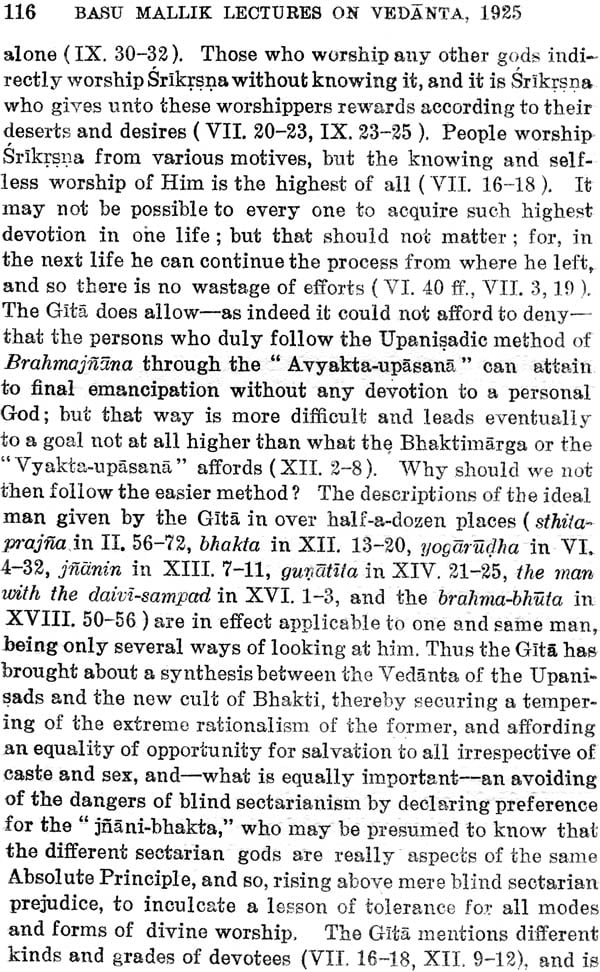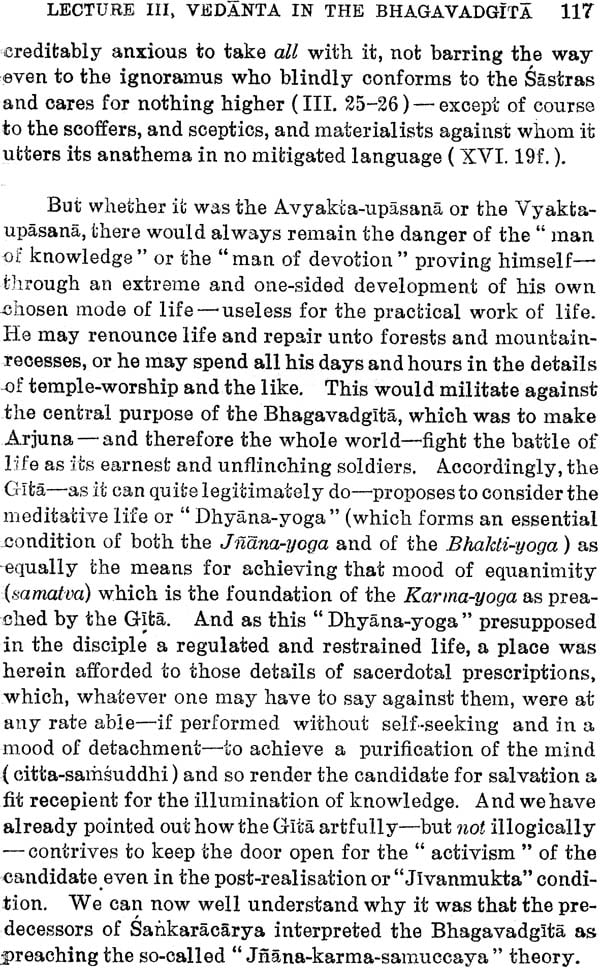
Vedanta Philosophy (Very Old and Rare Book)
Book Specification
| Item Code: | NAK920 |
| Author: | S.K. Belvalkar |
| Publisher: | Bhandarkar Oriental Research Institute, Pune |
| Language: | English |
| Edition: | 1929 |
| Pages: | 255 |
| Cover: | Paperback |
| Other Details | 8.5 inch X 5.5 inch |
| Weight | 290 gm |
Book Description
The terms of the Foundation according to which I waft called upon, in October 1925, to deliver at Calcutta, under the auspices of the University, a course of at least twelve lectures in English on " Vedanta Philosophy" required the Lecturer to deal in particular" with the place occupied by the Vedanta in the philosophical systems of the civilised world, and of its merits as compared with Western Schools of Thought." The terms at first sight appear as though they want to impose a specific view-point about the Vedanta; but considering that, if thus narrowly interpreted, they would tend to render the Series of Lectures proposed to be delivered year after year uncommonly dull and stereotyped, I chose to follow out my own way of interpreting the term Vedanta and my own method of dealing with the subject. And as this may seem to differ from the average notions about the" Vedanta Philosophy," I may here permit myself a word of explanation.
In common parlance the term Vedanta is restricted to the "Advaita" or Monistic Vedanta of the type of Sankara's "Mayavada"; but this is not only unfair to the types of "Vedanta Philosophy" promulgated by Ramanuja, Madhva, Vellabha, Srikantha, and others, but it is even unfair to the actual Vedantio tsaohing as contained in the several Upanisads and in the Bhagavsdgita: texts which no Vedantic School refuses to admit as possessing an authority parallel to that of the Brshmasntres themselves. If the ultimate teaching of the "Vedanta"-whether derived from the earlier and the later Upanisads, or from the Gita and the Bhagavste, or from the Vedantesutraa proper (to say nothing of the various pro- pounders of the "Navya" or Modern Vedanta)-were exactly identical, as the orthodox opinion would have us accept, what would be the earthly interest of copying out the same formula now in the upright Roman Characters, now in the Cursive Italics, now in Asokan " Brahmi " and now in the current Devanagart"? The fact nevertheless that we are genuinely interested in following out the same form or formula in its divergent interpretation should prove that what really arrests our attention and deepens our interest is the environmental difference which must have led the promulgators of the "Vedanta" Philosophy to shift the emphasis from one aspect to another, and to vary the metaphors and the arguments to suit the specific cases before them. Like Literature and Art, Philosophy is ultimately" a criticism of life," and unless we possess a tolerably definite notion as to how the "life" presented itself to a given people or to a given age, we cannot be in a position to grasp the very core of the issue. Philosophy is not a formula in Mathematics which you can study and analyse and criticise without giving any heed to its author or to the circumstances that may have led to its enunciation.
This naturally involves at each stage the question of fixing the texts and settling the dates-at least relatively, where absolute certainty may be unattainable. In Indian literary history, where all dates are like" pins set up to be bowled down again," this would no doubt be a peculiarly difficult task, affording widest scope for guess-work; but we cannot well avoid it. We may not, for instance, even now arrive at a consensus of opinion about the date of the Bhagavadgtta ; but I feel no hesitation in confessing that my philosophical estimate of the Poem regarded as Pre-Buddhis-tic would be entirely different from my estimate of the same Poem regarded as falling between 200 before and 200 after Christ. Further, the facility with which most texts regarded as authoritative have suffered from sundry contaminations or pious" interpolations makes it necessary to introduce in a study of Philosophy much matter which is of purely philological interest, mainly because so very few of our important basic texts are available in reliable critical editions. Consequently, even at the risk of being dubbed "hypercritical,' we have to re-arrange texts like the Upanissds into chronological strata; we have to weed out all proved excrescences from texts like the Brahmasutras and the Bhagavadgita; and we have to preserve the most critical attitude in admitting as an authentic work of Sankaracarya anything and everything which masquerades as a genuine piece, no matter under whose sanction and authority.
All this virtually means writing a regular "History" of Vedanta Philosophy, and I may be said in a sense to have done that, although I hope that I have not absolutely given the go to the purely philosophical side as such. Within limits I am prepared to follow Hegel's dictum as to the identity of History and Philosophy. And as this part of the programme, in view of the paucity of systematic works bearing on the theme, naturally took up considerable space, I had to throw the matter bearing upon the comparison between the Indian and the Western "Vedanta" into the briefest possible compass. Comparisons very often tend to .become superficial because no two things or systems, in their sources, surroundings, and life-purpose, are like enough to afford adequate basis for really helpful generalizations.
Between the notice of my election to the Lecturership and the date fixed for the delivery of the Lectures at Calcutta there remained an interval hardly sufficient for even the mechanical task of writing out the Lectures in a form that could be at once placed into the hands of the printer. Hence, with the exception of the first two, I had to deliver these Lectures, from brief jottings only. These I was permitted to elaborate subsequently. This has made the Lectures, in the bulk and form in which they appear in this book, no longer "lectures" that could be orally delivered in the course of an hour or so. This was inevitable. It meant also more expense and delay. But I had no idea that the latter would be so great as to compel me to issue the Lectures in two Parts of about 250 pages each. I at first estimated for a volume of about 350 pages of the present formal for all the Lectures, and secured Swadeshi paper of a uniform quality and colour to suffice for the purpose. But when I found that the estimate would be exceeded, I also discovered to my surprise that it would be very difficult to secure from the Mill further stock of paper of exactly the same colour and quality unless I chose to wait and take a chance. This was the immediate circumstance that led to the decision of issuing the Lectures in two separate Parts, which mayor may not be afterwards welded into one Volume. Th4i pagination will not be continuous, although an Index for all the Lectures, as also a Glossary of Sanskrit words with their English equivalents, will be given only at the end of the Second Part.
The material for the Second Lecture included in this Part is derived from the Second Volume of the History of Indian Philosophy by Professor R. D. Ranade and myself, published in 1927. It is here presented' in a succinct and somewhat improved form. The major part of the Third Lecture, including the •• Summary of the Gita, to was put together in connection with my lectures on that philosophical Poem which I delivered three times in the course of the last six years to my Sanskrit B. A. students at the Deccan College, successively touching and revising the same. My main differences with the late lamented Professor R. Garbe of Tubingen regarding the interpretation of the Gita I had communicated to him by letters, and I am really sorry to see that he has not been spared to read my arguments in extenso and pass his judgment upon the same. My views about the constitution of the Brehmasntras as developed in Lecture IV I am submitting with deference to the judgment of scholars like Professor H. Jacobi, whose arguments about the date and the interpretation of the Sutras I find myself unable to accept in toto. I admit that the Brahmaeutras deserve to be made the subject of a much more thorough-going study than what I have been able to comprise within the brief span of forty pages. This I hope to do elsewhere. For the fifth Lecture I was eagerly waiting for the appearance of the long announced Volume on the "Agamasastra of Gaudapada" by Professor Vidhusekhara Bhattacharya of the Santiniketan, which, so far as I am aware, is not yet out. For many of the Karikas I have been led to arrive at distinctive renderings of my own, which could not all be embodied in the Lecture, but which could now be possibly included in a critical edition of the Gaudapadiya karikas, which I have been, from several quarters, urged to undertake. On the vexed question of the age and the literary entourage of Sankaracarya, dealt with in the last Lecture contained in this Part, I have had the rare privilege of discussing the whole question personally with my old Guru, Professor K. B. Pathak, upon whom the University of 'I'ubingen has recently most deservedly conferred the Doctorate in Philosophy (Honoris Causa), and who, even at the advanced age of 80, is now engaged in writing important original papers and bringing out a collected edition of his Works. I have also derived considerable help from a careful compilation of the data deducible from all the minor and major works attributed to Sankaracarya made by my student, friend and colleague, Mr. R. D. Vadekar, whose constant cooperation in my literary undertakings may now be said to have passed the limits of a formal thanks-giving.
In conclusion I must express my indebtedness to the University of Calcultta who honoured me by its invitation to deliver this Series of Lectures, and who granted me all other facilities concerning the publication of the same. I only hope that these humble Lectures of mine are deemed a tribute worthy of acceptance by the Premier University of India.







